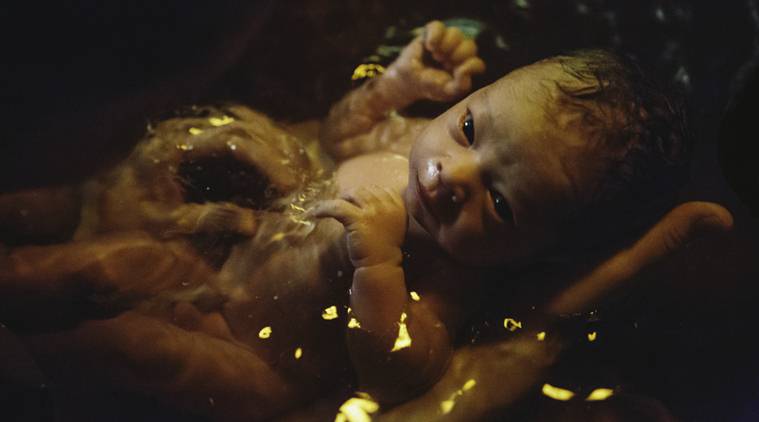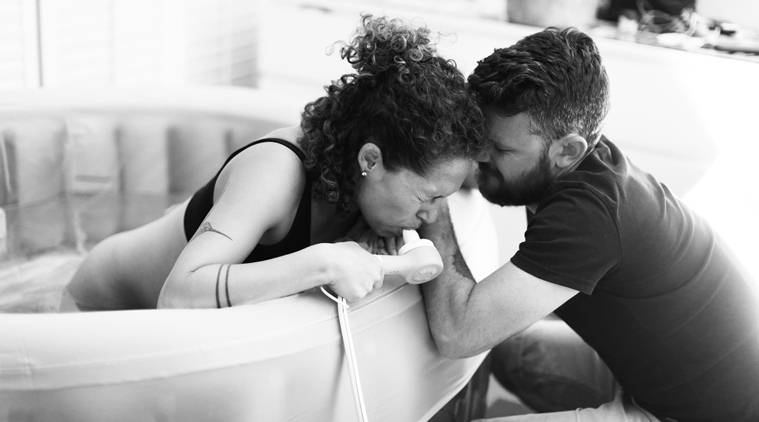While conventional labour delivery involves routine interventions which can be painful to the mother, like episiotomy (a surgical cut made near the vagina), in water birth, the mother spends the final stages of labour in a birthing pool which allows for a more relaxing, comfortable, and less complex delivery process.

Recently, Brazilian model-turned-actor Bruna Abdullah, who is expecting her first child with fiancé Allan Fraser, revealed that she will opt for water birth for her child. “I always knew that if I had a baby, I would go for water birthing. I love water and the thought of being in a warm pool, feeling relaxed and waiting for my baby, is the best thing I can ask for,” Abdullah, who has acted in films like I Hate Luv Storys and Grand Masti, reportedly said in a Bombay Times interview.
In India, while childbirth and motherhood are commonly projected as the most gratifying experiences for a woman, scare-mongering, tales of excruciating labour pains and births gone wrong are often extensively told and re-told. Added to it is the “mechanical approach at hospitals” which is driving women to look for a more personalised and curated prenatal care and childbirth, turning the focus on concepts of natural and even home births.
Back in 2008, after the birth of her first child, Shivani Sharma realised how childbirth is viewed as a ‘suffering’ due to gruelling labour pains rather than ‘celebrated’ as a wonderful moment that carries glory with it. “I was disappointed when I saw how my friends and cousins who were giving birth came to imbibe the idea that child birth is plain suffering. After my daughter was born through a normal delivery, I started looking for more safer and gentler options for child birth and stumbled upon water birth delivery,” recollects the 41-year-old.
When Sharma was pregnant with her second child, she knew she wanted a “different birth experience”. She delivered her second child in 2015 in a tub at home and was happy with her decision. “I liked the feeling of not being in a hospital surrounded by sterile equipment, fluorescent lights and machines,” she says, adding that she was supported by two trained midwives, her doctor and her husband.
What is water birthing?
Among the natural birthing techniques gaining recognition is water birth, a birth in which the mother spends the final stages of labour in a birthing pool or a tub of warm water which allows for a more relaxing, comfortable, and less complex delivery process. Also, the slow transition of the baby from the water environment in the mother’s womb (amniotic sac) to the outside air environment after delivery “is a lot less drastic” as compared to a normal delivery.
Midwives, birthing centers, and a growing number of obstetricians believe that reducing the stress of labour and delivery will reduce foetal complications. “The effect of buoyancy lessens a mother’s body weight which allows for free movement. It also promotes more efficient uterine contractions and improves blood circulation resulting in better oxygenation of the uterine muscles, less pain for the mother, and more oxygen for the baby,” says Dr Astha Dayal from The CK Birla Hospital for Women (CKBHW), who has conducted several water birth deliveries.
Dr Dayal points out how there is no importance given to pain management which should not be the case. “In more controlled conditions, with the woman in control and no extra medicines, no needles, no instruments, there is naturally a more positive tendency created,” she opines.
CKBHW is one of the first hospitals in Gurgaon to conduct water births along with few other hospitals in India like Bloom Fertility and Healthcare in Chennai, and Kochi-based Birth Village.
It is believed that immersion in water often helps lower high blood pressure caused by anxiety. “The water seems to reduce stress-related hormones, allowing the mother’s body to produce endorphins which serve as pain-inhibitors,” Dr Dayal further adds, “contractions can feel shorter and less intense in the warm, soothing water.”
While conventional labour delivery involves routine interventions which can be painful to the mother, like episiotomy (a surgical cut made near the vagina), and labour augmentation where medicine is given to increase the strength of contractions, in water birthing, water causes the perineum to become more elastic and relaxed, reducing the incidence and severity of tearing and the need for an episiotomy and stitches.

“The ability to assume different positions, the warmth of the water, dim lighting in the room and fewer people present, all contribute to a better birthing atmosphere,” says Sanam M Manchanda, internationally certified labour doula (a birth coach or support) and a pre/postnatal counsel.
A water birth may be less stressful for the baby as well, and they may even cry less, adds Manchanda, who has been a part of births (natural, caesareans and water births) with well-known doctors such as Dr R P Soonawala, Dr Feroze Soonawala, Dr Ameet Dhurandar, and Dr Noser Cheriar among others.
Is water birth safe and for all mothers?
“It is quite safe. Babies born to mothers who labour in water are just as healthy as babies born to mothers who labour out of water,” says Dr Ritu Sethi, Principal Consultant, Columbia Asia Hospital, Palam Vihar, Gurgaon.
Though many people have positive experiences with water births, they’re not for everyone.
Water births are appropriate in low-risk pregnancies. However, if there are complications, such as placenta previa or vaginal bleeding, or if the baby is preterm or breech, the mother can’t deliver in water.
Despite all these benefits, why is water birth considered a ‘Youtube wonder’ in the country?
Many believe it stems from the lack of awareness of the concept and fear of harm to the baby. While survival chances are the same as conventional deliveries, the process has to be closely supervised so that the baby doesn’t swallow the water and is pulled out at the right time. “So the fear is very much there and is a major factor behind why patients do not opt for it,” Dr Sethi shares, adding how some parents are caught up in “old-fashioned ideas” and believe that “a delivery without pain is not a proper one”.
Yet, hoping for a more positive approach to water birthing, Manchanda points out that as of today, “the popularity of water birthing is increasing slowly day-by-day”.
“Families are realising that they have a positive alternative to normal birthing. I do hope that with time, more doctors adopt this way of birthing instead of following normal hospital procedures. Every woman must be given the opportunity to give birth to her baby as naturally as possible, and a water birth can definitely lead to this,” quips Manchanda.
Even though many healthcare centers have started offering water birth delivery, patients don’t go for it because of the high procedure cost, states Dr Sethi. “It costs at least a lakh more than a normal delivery.” However, Dr Dayal mentions that to make water birth more acceptable, CKBHW offers the service on par with normal delivery.
Towards a “wholesome” birthing experience
Interestingly, emphasising on a “wholesome” child birthing experience, hospitals like CKBHW are providing sessions for pregnant women on hypnobirthing (or a method of pain management that can be used during labour and birth and involves a mixture of visualisation, relaxation and deep breathing techniques) coupled with antenatal fitness sessions; pampering sessions and entonox gas or laughing gas sessions.
Pune-based Sharma, who is a hypnobirth practitioner herself for the past 10 years says that by understanding the needs of the mother, techniques like hypnobirthing can help manage stress hormones, such as adrenalin and reduce anxiety which should lead to a calmer birth.
“During labour, the mother’s body produces a chemical called oxytocin, which helps progress your labour. Stress hormones affect the production of oxytocin, and make your labour longer,” explains Sharma, adding that it may even benefit the mother after delivery, “with some evidence showing that it can lower the chance of postnatal depression”.
Hypnobirthing, doula support, water birth are all new concepts for our country but can help prevent the rates of “unnecessary caesarians being done”, feels Manchanda. “Such alternative birthing methods are definitely changing the dynamics of our birth industry, and if families put in efforts to become more researched, there is definitely hope,” says Manchanda.
Source: Read Full Article
